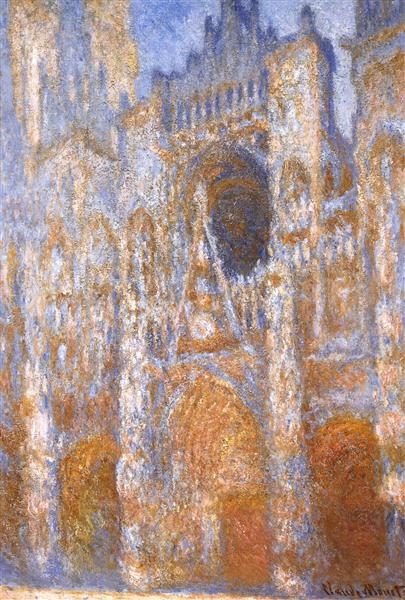Description
The work "Cathedral of Rouen - the portal at noon", painted in 1893 by Claude Monet, is a forceful testimony of the impressionist approach that defined much of his career. This piece is registered within a series of approximately 30 paintings That Monet made of the same cathedral, immersing himself in the study of his facade in different conditions of light and atmosphere. Monet's choice of this topic is not trivial; The cathedral, with its imposing Gothic architecture, becomes a perfect setting to explore the relationship between light and form, something that fascinated the artist.
Monet presents a frontal view of the main portal of the cathedral, where the structure is erected as a monumental silhouette against a radiated sky of light. The composition of the work is remarkably vertical, emphasizing the height and majesty of the building. Despite the presence of well -defined architectural elements, Monet chooses a loose and almost vaporous execution. The loose brushstroke and the use of color results in an atmosphere that, although anchored in a specific place, feels transformed by the changing light of the day. The 'color division' technique is evident; Monet uses short brushstrokes of pure colors to capture the luminosity, creating a sense of movement and vivacity that characterizes the essence of impressionism.
The colors of the paint are warm and vibrant, predominantly the yellow and orange tones that highlight the warm noon. The mixture of these colors with blue nuances at the top of the painting It helps transmit the intensity of that moment of the day. Monet makes use of subtle contrasts to give life to the stone of the cathedral, suggesting shadows that provide depth without losing the ethereal luminosity that floods it.
Throughout the series of the Rouen cathedrals, Monet distances himself from the literal representation of architecture, focusing on his ephemeral character. This allows the viewer to experience the cathedral not as a mere physical object, but as a living entity that changes with light and atmosphere. In "the portal at noon", there are no human figures to encourage the scene; Instead, the cathedral becomes the absolute protagonist, an immortal stone relic that, through Monet's work, seems to come alive.
One of the most captivating aspects of this work is precisely its intersection between the lasting and the fleeting. Monet invites us to reflect on the importance of the moment captured in the painting, an instant in which the sacred and the temporal are found. The cathedral, a symbol of permanence, is represented in a dynamic state, as ephemeral as the moment of light that bathes it.
Monet's impressionist technique has greatly influenced not only its contemporaries but also in later generations. When capturing the mathematician shipwrecked of the light and the atmosphere, its approach has opened doors to new ways of seeing and feeling the painting, releasing it from the chains of realism and proposing a continuous dialogue between reality and perception.
In conclusion, "Rouen Cathedral - the portal at noon" is more than a representation of an emblematic building; It is an exploration of the meaning of light, perception and temporal experience. Monet's work leads us to a deep reflection on our own experience of the environment, inviting us to see beyond what is merely physical, to capture the essence of what we feel when contemplating a corner of the world, even one as great as a Gothic cathedral. In each brushstroke, we find a universe of sensations locked in an instant, turning the everyday into extraordinary through art.
KUADROS ©, a famous paint on your wall.
Hand-made oil painting reproductions, with the quality of professional artists and the distinctive seal of KUADROS ©.
Reproduction service paintings With a guarantee of satisfaction. If you are not completely satisfied with the replica of your painting, we refund your money 100%.

